Exploring the Diversity of Quartz: Types and Characteristics
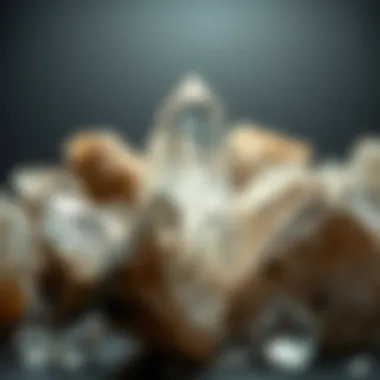
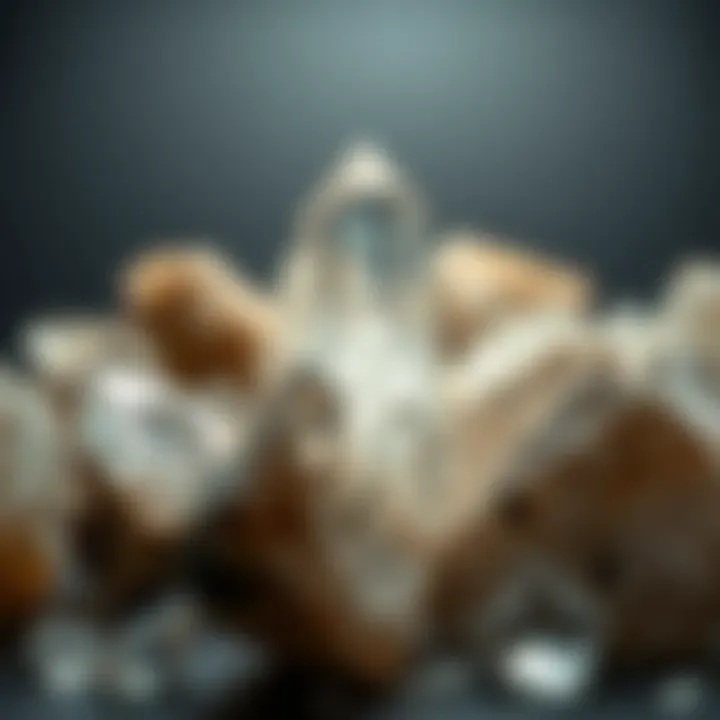
Intro
Quartz is not just plentiful; it’s a canvas of nature’s artistry, presenting a multitude of forms that have intrigued collectors, scientists, and hobbyists alike for centuries. Each quartz type is a story waiting to be told—from the clarity of a pristine crystal to the soft blush of rose quartz, the diversity of this mineral extends far beyond what meets the eye. Understanding quartz is akin to unwrapping an enigmatic gift, layer by layer, revealing textures, colors, and uses that have woven seamlessly into human history and culture.
As we embark on this exploration, we’ll not only catalog the prominent varieties like clear quartz, amethyst, citrine, and smoky quartz but also revel in the richness of rarer types that may have slipped under your radar. With an eye for detail, this article offers insights into their formation, unique properties, and practical applications, enabling both enthusiasts and professionals to deepen their appreciation of quartz in both geological and cultural contexts.
This endeavor is designed to resonate with rock and fossil collectors seeking to enhance their knowledge, as well as casual readers who may simply be captivated by nature's wonders. So, let’s delve into the fascinating world of quartz—where each crystal is a testament to the myriad forces that shape our planet.
Prelims to Quartz
Understanding quartz is paramount for anyone diving into the world of minerals, gemstones, or even geology as a whole. This remarkable mineral stands proudly as one of the most ubiquitous substances on Earth and plays a significant role not just in nature but also in various human industries and cultural practices.
What is Quartz?
Quartz is primarily composed of silicon dioxide (SiO2), and it's one of the most common minerals found in the Earth's crust. This mineral can present itself in a multitude of forms, which often leaves enthusiasts and collectors completely awestruck. With over 200 varieties identified, its allure lies not only in its myriad of colors and patterns but also in its impressive hardness and ability to withstand significant environmental wear. Collectively, these traits make quartz a focal point in both natural history and modern applications.
Formation of Quartz
Quartz forms through several methods, notably crystallization from molten rock, as well as through the precipitation from solution. It can arise in igneous, metamorphic, and sedimentary environments, showcasing its adaptability. One interesting aspect is that it often takes the shape of hexagonal prisms, reflecting its crystalline structure. This formation process involves atoms arranging themselves in orderly patterns, leading to the diverse varieties we recognize today.
Minerals like quartz usually require considerable time to develop, often spanning thousands to millions of years. Just consider the Earth’s geological history: the story etched into each piece of quartz can reveal insights about the processes this planet has undergone, from volcanic eruptions to the slow drift of tectonic plates.
As such, quartz isn't just another pretty stone; it tells a tale of time, of the planet's formative forces, and of the deep past that shaped our natural world. Understanding both what quartz is and how it forms sets the stage for much deeper exploration into its vast diversity.
Categories of Quartz
Understanding the categories of quartz is essential not only for experts, but also for enthusiasts and collectors alike. The distinctions between these categories play a significant role in identifying different types of quartz, determining their value, and understanding their properties better. Moreover, each category possesses unique attributes that can enhance aesthetic appeal or functionality in various applications.
When we talk about quartz, it’s not just a single entity; it branches out into various types, each defined by its crystalline structure and formation. Knowing whether a quartz is crystalline or cryptocrystalline can help in recognizing how it was formed, along with its potential uses. This knowledge also aids collectors in knowing what they are acquiring, thereby enriching their collecting experience.
Crystalline vs. Cryptocrystalline Quartz
When it comes to classifying quartz, the primary distinction is between crystalline quartz and cryptocrystalline quartz. This separation is based largely on how the mineral crystallizes and the nature of its structure.
Crystalline Quartz
This type forms in larger, well-defined crystals, which typically exhibit clear geometric shapes. Crystalline quartz includes popular varieties like amethyst and citrine. When held up to the light, you can often see how well-structured and clear these minerals can be.
- Characteristics:
- Transparent or translucent
- Distinct hexagonal prisms
- Can contain inclusions or other minerals
Examples: Some noteworthy types of crystalline quartz include:
- Amethyst: A purple variety often associated with tranquility.
- Citrine: Ranges from yellow to brown and is tied to prosperity.
- Smoky Quartz: Exhibits a brownish hue that can be quite striking.
Cryptocrystalline Quartz
In contrast, cryptocrystalline quartz consists of tiny crystals that are not visible to the naked eye, thus forming a more opaque appearance. This type often appears as aggregates or as smooth stones, making it highly valued for ornamental purposes. Varieties such as chalcedony and agate are examples of this category.
- Characteristics:
- Opaque to translucent
- Composed of microcrystalline structures
- Often banded or patterned
Examples:
- Agate: Known for its beautiful bands and variety of colors.
- Jasper: Typically contains unique patterns and is often used in jewelry.
- Chalcedony: Often used for carvings or in small decorative items.

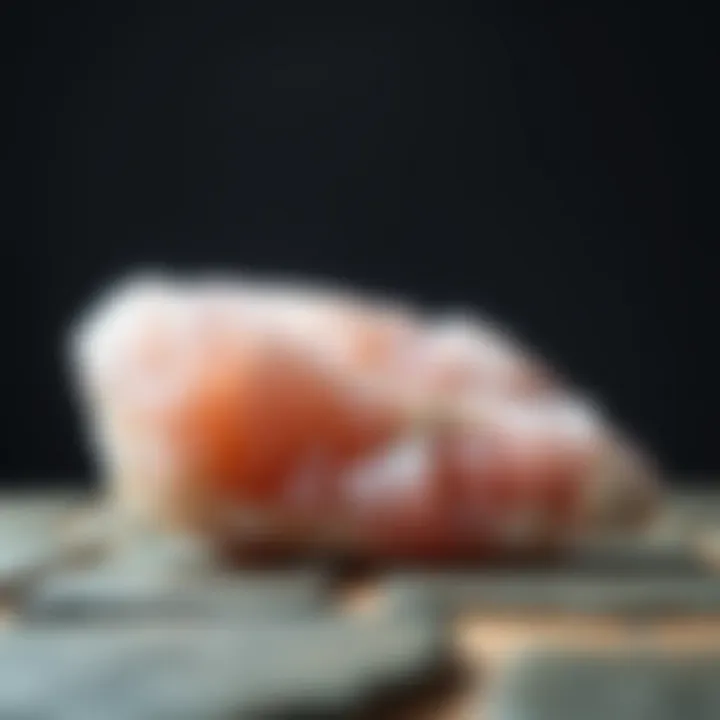
In summary, distinguishing between crystalline and cryptocrystalline quartz simplifies identification and enables collectors to appreciate each type's unique aspects. The beauty and diversity of these quartz categories do not just make them appealing, but also empower individuals in their pursuits, whether for personal enjoyment, scientific study, or investment opportunities.
Understanding these categories can significantly influence your appreciation of quartz, transforming what might seem like simple rocks into remarkable pieces of geological art.
For more in-depth information on quartz characteristics, consider checking resources on Britannica and Wikipedia.
Link to different forums and discussions can be found on platforms like Reddit where enthusiasts share their findings and experiences.
Common Varieties of Quartz
Understanding the common varieties of quartz is essential not only for those within the mineral collector community but also for anyone keen on exploring the natural world. Each type of quartz presents unique properties and visual characteristics, making them distinct and valuable for collectors, jewelry makers, and even those interested in metaphysical properties. The significance of these varieties extends beyond aesthetics; they often embody geological stories, cultural meanings, and have various practical applications.
In this section, we will explore several well-known types of quartz, breaking down their features, uses, and the charm that makes each of them a gem in the rough.
Clear Quartz
Often hailed as the most versatile and popular variety, clear quartz is characterized by its transparency and high clarity. This quartz type is often referred to as "rock crystal" and can be found all around the globe. Its chemical structure allows it to be easily fashioned into various shapes, making it a top pick for lapidaries.
Clear quartz is commonly used in a multitude of applications ranging from electronics and optics to healing practices. In the realm of crystal healing, it's thought to amplify energy or intention, acting as a conduit for more subtle energies. This property is what draws many enthusiasts and practitioners to this crystal, often placing it at the heart of their collections.
Amethyst
Amethyst, a luxurious purple form of quartz, captivates many with its deep, rich hues ranging from light lavender to almost black. The purple coloration comes from iron impurities and natural radiation within the quartz. Lovers of this stone often use it in jewelry; the hue looks striking in both silver and gold settings.
Beyond its aesthetic appeal, amethyst carries substantial symbolic weight. Historically used by ancient civilizations, such as the Greeks who believed it could prevent intoxication, today it is often associated with calmness and clarity. Collectors value not just its beauty, but the stories and traditions that accompany each piece.
Citrine
Don't let its sunny disposition fool you; citrine is more than just a pretty face. Ranging from pale yellow to deep amber, this variety of quartz is often dubbed the "merchant's stone" for its historical ties to prosperity and abundance.
One of the unique features of citrine is that it is typically formed from the heat treatment of amethyst or smoky quartz. This phenomenon makes natural citrine rarer, which drives its desirability and value among collectors. Many fans of crystal work use citrine to attract wealth, promote positivity, and for protection against negative energies.
Rose Quartz
Soft pink and tranquil, rose quartz is often known as the "love stone." Its gentle hue reflects its association with romantic love, self-love, and emotional healing. The color comes from trace amounts of titanium or iron minerals, providing it with a delicate charm that is hard to overlook.
From jewelry to decor, rose quartz finds its way into many people's lives. It's not just about its looks; collectors and practitioners believe in its energy to foster compassion and open the heart. This stone's popularity in physical and emotional healing makes it a staple in both personal collections and spiritual practices.
Smoky Quartz
Smoky quartz varies from light grey to deep brown, reminiscent of a dusky sky. This variety is especially known for its grounding properties, said to help anyone who feels overwhelmed. Smoky quartz's color arises from natural radiation affecting the silicon dioxide structure, giving each piece its own unique appearance and energy.
Collectors appreciate smoky quartz for both its utility and intriguing aesthetics. Many believe that it can help absorb and transmute negative energies, providing a protective barrier against external stressors. Its versatility lends itself well in both jewel crafting and as an enchanting display piece.
Milky Quartz
Milky quartz, characterized by its opaque white appearance, is another common variety that garners interest. Its cloudiness comes from trapped gas and fluid inclusions that occurred during its formation. This milky aspect presents the stone as soft yet powerful, often leading to its use in various jewelry forms.
Much like its clear counterpart, milky quartz is believed to have cleansing and healing properties. It's commonly associated with the moon and its energies, making it popular among those who practice lunar rituals or seek tranquility in their lives. Its availability makes it an accessible choice for novice collectors.
By understanding these common varieties of quartz, one can appreciate not only their beauty but also the deeper meanings and cultural significance they hold. Collectors find pleasure in sourcing these gems, uncovering their unique stories, and embracing the diversity of quartz in their own ways.
Rare Varieties of Quartz
The exploration of quartz rarely ventures beyond the well-known types, leaving a goldmine of rarer varieties untouched. However, understanding these uncommon forms of quartz can enrich both collectors’ engagements and our comprehension of this mineral's multifaceted character. Rare quartz varieties often possess unique visual traits or interesting histories, attracting those with a keen eye for detail. Knowing their characteristics provides rock and fossil collectors with an opportunity to elevate their collections, not just in terms of aesthetic appeal but also in the narratives these stones can tell.

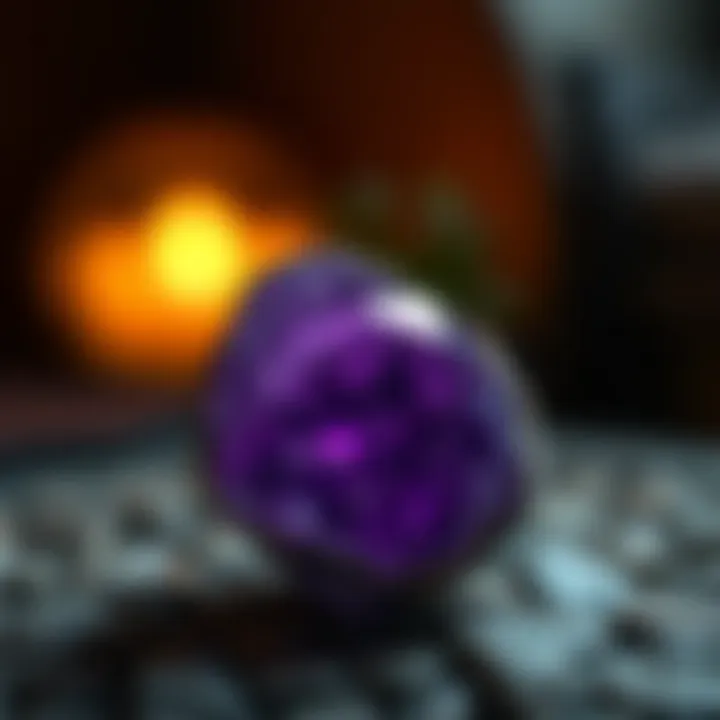
Ametrine
Ametrine is a captivating gemstone resulting from a natural fusion of amethyst and citrine. Found primarily in Bolivia, this striking quartz showcases a gorgeous interplay between the purple hues of amethyst and the golden tones of citrine. The formation of ametrine occurs under conditions where quartz crystals are subjected to varying temperatures, or more intriguingly, where there are different iron content levels during the crystal formation. As a result, stones may display beautiful zoning where the two colors meet, creating a dynamic visual appeal. Collectors appreciate ametrine not merely for its beauty but also for its unique story of formation, making it an outstanding addition to any mineral collection.
Enhydro Quartz
Enhydro quartz is quite the wonder, featuring tiny water bubbles trapped within its crystalline structure. The presence of these inclusions adds an enticing layer of curiosity for anyone who encounters it. The term "enhydro" is derived from the Greek word for water, aptly reflecting its characteristic feature. This variety often suggests information about the geological environment that allowed it to form, creating a fascinating conversation piece for mineral enthusiasts. Careful examination may reveal air bubbles that move within the water, reminiscent of ancient geological processes, making each piece a window into the earth's history.
Tiger's Eye
Tiger's Eye is perhaps one of the more recognizable of the rare quartz varieties but still deserves a closer look. Characterized by its chatoyancy—a term for the glowing, reflective banding effect—the stone resembles the eye of a tiger, hence its name. The unique optical property arises from the presence of fibrous inclusions of crocidolite that have been altered by silica. Collectors often seek out tiger's eye for its remarkable sheen and the feelings of protection and grounding it is said to offer. Its rich golden and brown tones can elevate the aesthetic of any rock collection, but its metaphysical attributes make it a real gem for collectors interested in spiritual and healing properties.
Cat's Eye
Another interesting member of the quartz family, Cat's Eye, is known for its striking appearance that resembles a lustrous feline pupil. This optical effect, or chatoyancy, is primarily due to the oriented fibrous inclusions present in the stone. Unlike standard tiger's eye which shows a horizontal band, cat's eye quartz reflects light from a single line across the surface, creating a captivating visual dynamic. Varieties of cat's eye stretch from colors ranging from pale yellows to vibrant greens. Collecting cat's eye quartz can be an exhilarating pursuit, as the rarity of good specimens makes them both collectible and desirable for unique jewelry pieces.
Opalized Quartz
Opalized quartz doesn’t fit the mold too easily—it’s a delightful hybrid of quartz and opal. This interplay creates stones that exhibit both the hardness of quartz and the iridescent qualities of opal. Found in a few select locations across the globe, like Australia, where opals are typically mined, opalized quartz serves as a prime example of nature's ability to combine elements to create something entirely different. The variations in color and visual effects displayed by opalized quartz pieces can make them an eye-catching centerpiece in any collection. The rarity and unique formation process add an extra layer of allure for collectors who appreciate unique pieces.
Quartz in Industry
Quartz plays a crucial role in various industrial applications due to its unique properties. Its abundance, stability, and versatility make it an essential material in different sectors, particularly electronics and optics.
Use in Electronics
In the realm of electronics, quartz is often referred to as the backbone of modern technology. Its primary use lies in piezoelectricity, where quartz crystals generate an electric charge when subjected to mechanical stress. This property is pivotal for precision timing devices like watches and clocks. Many smartphones also utilize quartz crystal oscillators to maintain accurate time and frequency, leading to the synchronization of various components.
Some specific applications where quartz's durability shines include:
- Resonators: Used in radio frequency applications to filter signals and maintain stable frequencies.
- Surface Acoustic Wave Devices (SAW): Employed in sensors and telecommunications for improved signal processing.
- Microelectromechanical Systems (MEMS): Incorporated into tiny mechanical systems used in various consumer electronics.
Application in Optics
Quartz's optical qualities further enhance its utility in industry, especially in the field of optics. Fused quartz, a type of silica glass produced by melting high-purity quartz, exhibits excellent transmission of light across a wide range of wavelengths. This characteristic makes it highly valuable in areas such as:
- Lenses and Prisms: Commonly used in high-precision optics, including camera lenses, telescopes, and microscopes, allowing for sharp images.
- Fiber Optics: Quartz fibers transmit light signals with minimal loss, allowing for high-speed internet and telecommunications.
- UV and NIR Windows: Used in spectrophotometers and analytical instruments to analyze light without interference from other materials.
"The ability of quartz to withstand extreme conditions while maintaining optical clarity ensures its dominance in optical applications across various industries."
Cultural and Historical Significance
Quartz has played a multifaceted role not just in geology but also in the cultural and historical narratives of human civilization. This section aims to unravel the intricate connections between quartz and the societies that have revered it throughout the ages. The significance of quartz extends far beyond its physical properties, embodying meanings and values that resonate deeply with various cultures across time.
Quartz in Ancient Civilizations
Ancient societies recognized quartz not only as a mineral but as a powerful material steeped in mystique. The Egyptians, for instance, utilized quartz in their jewelry and amulets, believing it to harness protective qualities. This practice was not just about adornment but served a deeper purpose.
The ancient Romans used clear quartz in their glass-making, appreciating its transparency and resemblance to water. It was also said that they believed quartz could enhance clarity of thought and perception. In Asia, particularly in China, quartz was highly regarded for its supposed ability to ward off evil spirits. Artisans carved it into various forms for both aesthetic and practical use in daily life, creating everything from tools to intricate decorations for their homes and temples.
- Egyptians: Used quartz in amulets for protection.
- Romans: Implemented it in glass-making and believed in its clarity-enhancing qualities.
- Chinese: Crafted tools and decor, seeing it as a spiritual ward against evil.
Symbolism of Quartz in Various Cultures
The value of quartz is seen differently across cultures. For many Native American tribes, quartz crystals are considered sacred tools for healing and spiritual rituals. The belief is that these crystals can act as amplifiers of energy, tapping into the spiritual world.

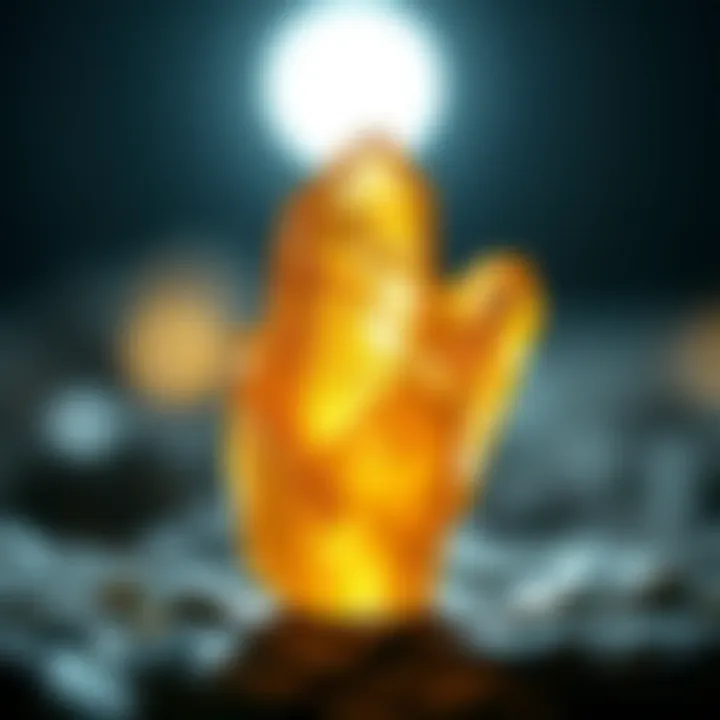
In Hinduism, quartz is often linked to the concept of energy and chakras, bolstering the energetic alignments within the human body. The clear quartz, in particular, is associated with purity and clarity of mind.
The myriad of meanings attributed to quartz can also be seen in its varied nomenclature; different cultures have unique names and leanings toward specific types of quartz. Additionally, whether viewed as a medicine stone or a tool for divination, quartz maintains a reputation as a medium of power.
"Quartz is not just a mineral; it is a vessel of ancient wisdom, capturing the essence of human experiences through time."
In summary, the cultural and historical significance of quartz illustrates how this mineral has transcended its role as a mere geological specimen. It has woven itself into the very fabric of history, spirituality, and daily life across numerous civilizations. The interplay of quartz's physical attributes and the beliefs surrounding it enhances not only our understanding of this mineral but also of the cultures that honored it.
Identifying Quartz Varieties
Understanding how to identify various types of quartz is not just an academic exercise but a valuable skill for collectors, gem enthusiasts, and those interested in geology. The ability to distinguish between the different varieties of quartz enhances appreciation and informed choices when acquiring specimens. This section will help elucidate key aspects regarding identifying quartz to ensure you are able to recognize its captivating diversity effectively.
Physical Characteristics
When we talk about quartz, its physical characteristics serve as the first indicators for identification. Each variety of quartz boasts its own set of visual and tactile features. Here’s what to look out for:
- Color: The hue is often the most striking feature. For example, amethyst is known for its rich purple color while citrine brings vibrant yellows and oranges. Conversely, clear quartz, also known as rock crystal, is often colorless and transparent, acting as a blank canvas for various aesthetic interpretations.
- Transparency: Some quartz, like clear quartz, is completely transparent, whereas others, such as milky quartz, might appear cloudy due to inclusions.
- Luster: Quartz generally displays a glassy luster. However, the way light interacts with each variety can change, giving distinctive appearances when cut or polished.
- Crystal Shape: Quartz typically forms in hexagonal crystals. Clear quartz demonstrates this structure most prominently, whereas varieties like smoky quartz and rose quartz might show different growth patterns.
- Inclusions: Many varieties of quartz have unique inclusions which can be clues for identification. For instance, rutile inclusions can be seen in rutilated quartz, while ametrine is a striking mixture of both amethyst and citrine within the same crystal.
"The beauty of quartz lies not just in its variety, but in the unique stories each specimen tells through its characteristics."
Testing Methods
To accurately identify and classify quartz varieties, practical testing methods go a long way. While physical observation is crucial, some tests can provide additional confirmation:
- Hardness Test: Quartz ranks 7 on the Mohs scale of mineral hardness. This means it can scratch glass and be scratched by topaz or harder materials. Using a simple glass plate can provide a preliminary check – if quartz scratches the plate, it offers some confidence in its identification.
- Acid Test: Some quartz varieties are prone to certain reactions when placed in acid. Though quartz doesn't react with dilute hydrochloric acid, knowing how insensitive some varieties can be helps in reaffirming its type.
- Refractive Index: Using a refractometer can help you determine the refractive index—a key tool in differentiating between quartz and other similar minerals.
- Polarizing Microscope: For more serious identification, a polarized light microscope can reveal valuable information on mineral inclusions and help distinguish between different quartz types at a microscopic level.
- Specific Gravity: Using a balance scale with a fluid can help measure the specific gravity of quartz. Different varieties may have slightly different densities.
By applying a combination of these physical characteristics and testing methods, you gain a solid foundation for effectively identifying the fascinating and diverse varieties of quartz. Not only does this knowledge build a stronger connection to the mineral kingdom, but it also empowers you as you delve deeper into the world of rock and fossil collecting.
Care and Maintenance of Quartz
Taking care of quartz is more than just a practice; it’s an art form that preserves the beauty and integrity of this cherished mineral. Whether you're a seasoned collector or a budding enthusiast, understanding how to maintain these stones is vital. Proper care can prevent scratches, dullness, and potential damage while enhancing their natural luster. Plus, well-maintained quartz can be a real showstopper in any collection. Let's dive into the specific actions that can keep your quartz looking its best.
Cleaning Techniques
Cleaning quartz requires a delicate approach to ensure that the stone retains its shine and clarity. Here are some methods to consider when cleaning your quartz varieties, depending on their structure and surface features:
- Soft Cloth and Water: For most types of quartz, a simple routine involving a soft, damp cloth can work wonders. Wipe the surface gently to remove dust and debris. Avoid harsh chemicals, as they might cause the stone to lose its natural brilliance.
- Natural Soap Solution: In cases where more stubborn grime is present, mix a few drops of mild dish soap into warm water. Soak the cloth and wring it out before giving your quartz a gentle rub. Rinse it thoroughly with clean water to avoid soap residue, which can attract more dirt.
- Toothbrush Method: For quartz varieties with more intricate details or crevices, a soft-bristled toothbrush can be a great aid. Dip the brush in your soap solution and lightly scrub the areas, then rinse as before.
"Always remember to handle your quartz with care. A little effort goes a long way in maintaining its elegance."
- Avoid Abrasive Cleaners: Stay clear of abrasive pads or cleaners that can scratch the surface or dull the finish. Such damage is often irreversible, which is not something any collector wants to deal with.
Storage Recommendations
When it comes to storing your quartz, the right techniques can prevent scratches or worse, breakage. Here are some golden rules to ensure that your treasured pieces remain safe:
- Individual Pouches: Consider keeping each quartz piece in its own pouch. Soft fabric bags or pouches made from cotton are ideal, as they offer protection without scratching the surface.
- Avoid Direct Sunlight: While many quartz pieces can handle sunlight better than others, prolonged exposure can fade colors over time. Store your quartz in a cool, dry place, away from direct sunlight.
- Use a Display Case: For those who want to showcase their collection, a sturdy display case with soft padding can be crucial. Ensure it is dust-proof and temperature-controlled if possible.
- Keep Away from Other Crystals: Some crystals can scratch others. Store quartz separately or with softer stones to avoid damage.
In summary, care and maintenance of quartz not only enhances its aesthetic appeal but also preserves its long-term value. Following these cleaning and storage recommendations allows collectors to enjoy their quartz long into the future.
Culmination
Understanding quartz is not just an academic exercise; it is a window into both our planet's geological history and the myriad ways we have utilized this mineral throughout human civilization. The significance of quartz becomes evident when we consider its versatility and the crucial roles it plays in diverse fields ranging from technology to spirituality. For rock and fossil collectors, a deep awareness of the characteristics and varieties of quartz enriches appreciation and nurtures informed decision-making during collection.
The Importance of Understanding Quartz
Quartz isn’t merely a pretty stone; it is a symbol of resilience and transformation. The importance of grasping the characteristics of quartz extends across various facets:
- Natural Formation: Knowing where and how quartz forms in nature contributes to a more profound respect for geology. From igneous to metamorphic environments, its presence tells a story of time and pressure.
- Diverse Varieties: Each variety of quartz, like amethyst and citrine, carries distinct properties, making it essential to recognize these differences for both scientific and aesthetic purposes. Enthusiasts can identify what they’re collecting with informed confidence.
- Cultural Significance: The symbolism associated with quartz in various cultures—from healing properties attributed to rose quartz to the clarity of clear quartz—illustrates how societies have historically valued minerals. This knowledge can enhance your appreciation for each piece in your collection.
- Industrial Use: Quartz is not just a pretty face in a collector's cabinet. Its applications in electronics and optics reveal its significance in modern technology. Recognizing quartz's industrial role adds to its allure, knowing that it powers devices in everyday life.
"Quartz is not just a mineral; it's a connection to our earth and a bridge to our future."



